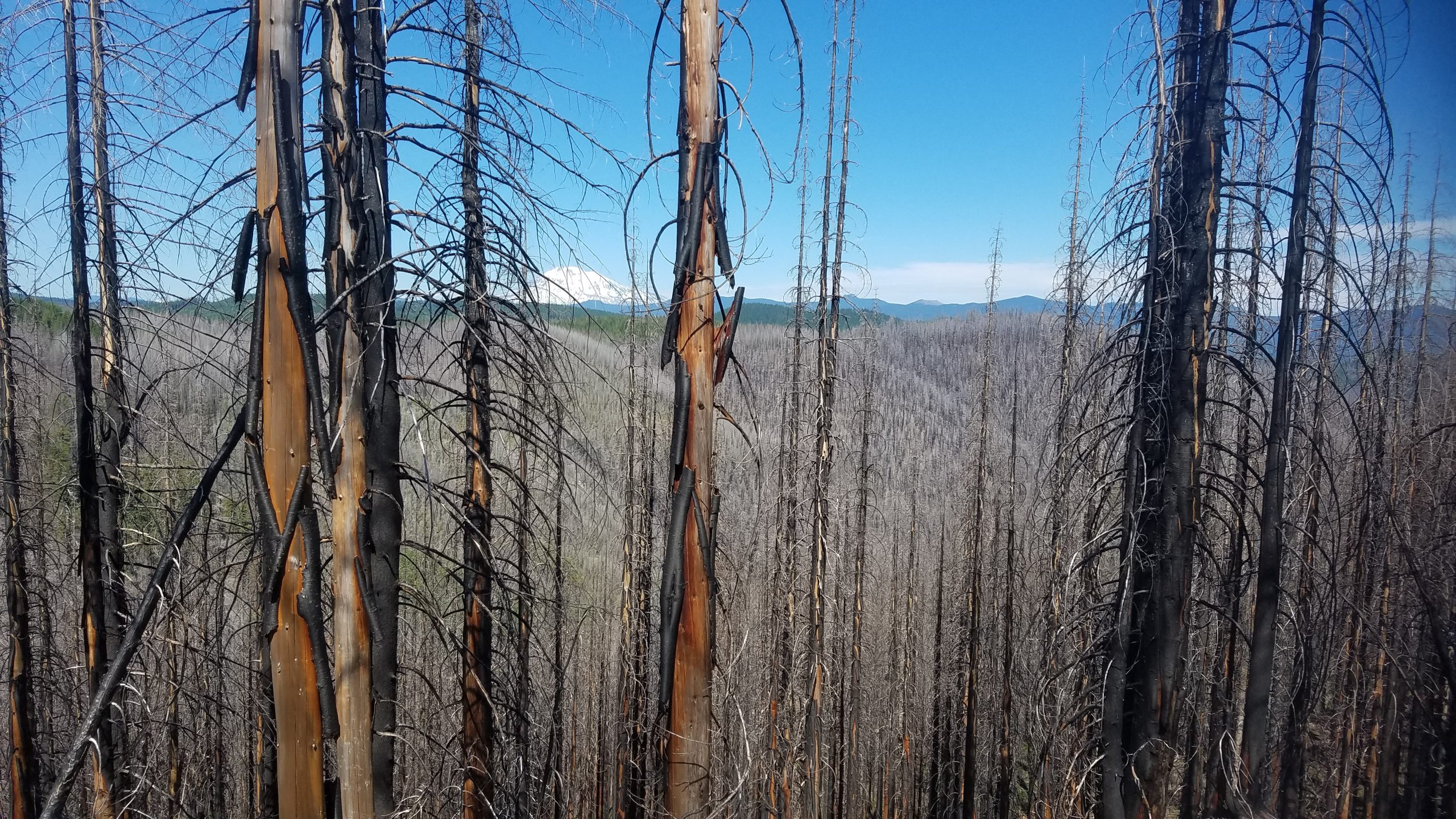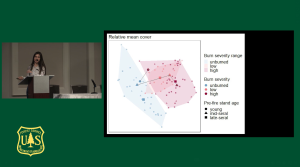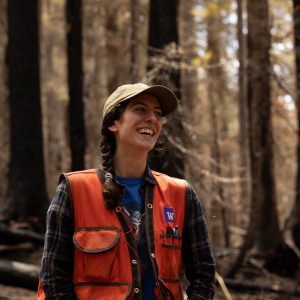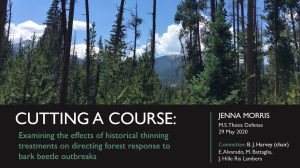New grants/fellowships – Congrats to Mia Mitchell! – Dec 2025

This fall, PhD student Mia Mitchell was selected for the 2025 American Geosciences Union (AGU) Biogeosciences DEI Travel Grant. She will use these funds to present her manuscript, “CHMer (Canopy Height Model-er): Leveraging Deep Learning for Site-Specific Sub-Meter Canopy Height Predictions” at AGU in New Orleans this December. Congratulations, Mia!
Congrats to Dr.(!) Jenna Morris! – June 2025
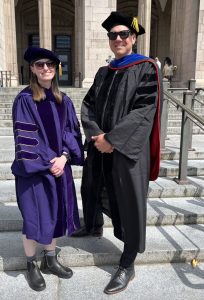
Congrats to Dr. Jenna Morris on completing her doctoral dissertation defense and graduating with her PhD in SEFS in June, with her dissertation titled ‘Post-fire carbon, fuels, and vegetation dynamics in wet temperate forests: Implications for future fire and management in the Pacific Northwest‘ now officially on the books. This summer, she will start a postdoc with UW-SEFS. Way to go, Jenna!
Congrats to grad student Madison Laughlin! – Mar 2025
(Photo coming soon)
Congrats to PhD Candidate(!) Madison Laughlin on passing her PhD General Exam in March, with her PhD proposal ‘Mechanisms, drivers, and implications of post-fire conifer seed legacies‘ now officially on the books. Way to go, Madison!
Congrats to grad student Angie Liotta! – Dec 2024
(Photo coming soon)
Congrats to PhD Candidate(!) Angie Liotta on passing her PhD General Exam in December, with her PhD proposal ‘Testing mechanisms of resilience to wildfire in dry interior forests of the Pacific Northwest: Seedlings and legacy trees’ now officially on the books. Way to go, Angie!
Congrats to Dr.(!) Don Radcliffe! – May 2024
(Photo coming soon)
Congrats to Dr. Don Radcliffe on completing his doctoral dissertation defense and graduating with his PhD in SEFS in June, with his dissertation titled ‘Dry forest fuel and biodiversity management in the Pacific Northwest‘ now officially on the books. This summer, he will start a postdoc with UW-SEFS. Way to go, Don!
Call for applications: Summer 2024 Field Crew Lead Position – Forest & Fire Ecology Research – Mar 2024
We are hiring a field crew lead for work in the forests of the Cascade Mountains. Please see the “Join” page for more information, and see the position description for information on how to apply. Positions are open until filled.
Call for applications: Summer 2024 Field Technician Positions – Forest & Fire Ecology Research – Mar 2024
We are hiring up to 6 field technicians for work in the forests of the Cascade Mountains. Please see the “Join” page for more information, and see the position description for information on how to apply. Positions are open until filled.
Congrats to Dr.(!) Michele Buonanduci! – May 2023
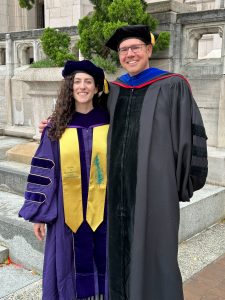
Congrats to Dr. Michele Buonanduci on completing her doctoral dissertation defense and graduating with her PhD in QERM and SEFS in June, with her dissertation titled ‘Spatio-temporal patterns of forest disturbance in western North America: implications for forest resilience’ now officially on the books. This summer, she will join The Nature Conservancy with a joint postdoc between TNC and UW-SEFS. Way to go, Michele!
Congrats to grad student Jenna Morris! – May 2023
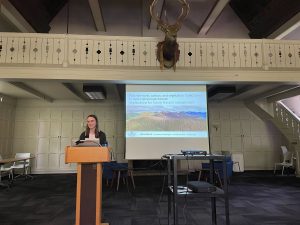
Congrats to PhD Candidate(!) Jenna Morris on passing her PhD General Exam in November, with her PhD proposal ‘Post-fire fuels, carbon, and vegetation trajectories in moist temperate forests: implications for future fire and management’ now officially on the books. Way to go, Jenna!
New grants/fellowships: Congrats to Madison Laughlin! – May 2023

This spring, PhD student Madison Laughlin was selected for the 2023 cohort of NW Climate Adaptation Science Center Research Fellowship Program! Her selection as a NW CASC Fellow will support research on mechanisms of resilience to fire in forests across northwestern Cascadia, setting up seed traps within the 2022 Bolt Creek fire to analyze seed abundance and composition in the first few years following fire across a range of burn severities. Madison will officially begin the fellowship in Fall 2023. Congratulations Madison!
New paper: What is the color when black is burned? Quantifying (re)burn severity using field and satellite remote sensing indices – Apr 2023
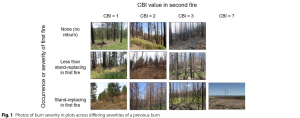
In this paper led by Saba Saberi, we compared the performance of two burn severity indices (in the field CBI and satellite RdNBR) against field-based severity measurements detailed in Saberi et al. (2022) in single-burn stands vs short-interval reburns across the Pacific Northwest, USA. We also compared the reliability of severity indices in assessing short-interval reburns following stand-replacing and low severity fires. The greatest divergence in severity index vs. field measures was found in short-interval reburns following a stand-replacing fire, with CBI and RdNBR underestimating burn severity in the forest canopy. Severity measurements of short-interval reburns following low severity fire more closely resembled single fire measurements, yet were found to overestimate burn severity on the forest floor. The results of this study bring to light the ways in which these widely used indices can improve, especially in the context of compounding disturbances and extreme burn severity. Find the link to this paper in our Publications page!
Five #HarveyLab talks at the 2023 USFS Post-fire Research and Monitoring Symposium in Corvallis, OR – Feb 2023
The Harvey lab was represented by five members and their outstanding talks at the 2023 USFS Post-fire Research and Monitoring Symposium in Corvallis. All presentations were recorded, and you can click on the image icons from the list below to watch!
Brian Harvey: Spatial patterns of burn severity in Western Cascadia: characteristics, drivers, and implications for post-fire landscapes
–
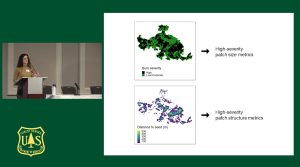 Michele Buonanduci: Examining wildfires from other regions and fire regimes yields insights into future patterns of burn severity in western Cascadia
Michele Buonanduci: Examining wildfires from other regions and fire regimes yields insights into future patterns of burn severity in western Cascadia
–
 Jenna Morris: Impacts of forest structure and fire severity on reburn potential in western Cascadia
Jenna Morris: Impacts of forest structure and fire severity on reburn potential in western Cascadia
–
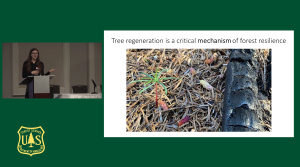 Madison Laughlin: Patterns and drivers of conifer regeneration following stand-replacing wildfire in western Cascadia
Madison Laughlin: Patterns and drivers of conifer regeneration following stand-replacing wildfire in western Cascadia
–
Liliana Rangel-Parra: Composition and diversity of early-seral forest communities vary with burn severity and pre-fire stand age following fire in western Cascadia
New paper: Fuel profiles and biomass carbon following bark beetle outbreaks: Insights for disturbance interactions from a historical silvicultural experiment – Feb 2023

In this paper led by Jenna Morris, we explored the effects of historical (1940s) silvicultural treatments on fuel profiles and aboveground biomass carbon ten years following mountain pine beetle (MPB) outbreak in the Fraser Experimental Forest in Colorado, USA. Historical cutting led to reduced surface fuel loads and greater live canopy fuels in heavily cut stands compared to uncut stands. Aboveground live biomass carbon in cut stands was approximately double—and dead biomass carbon half—that of control stands, respectively, though total aboveground biomass carbon levels were similar across all stands. Overall, these results indicate that reduced MPB outbreak severity due to historical cutting treatments may accelerate recovery of post-outbreak live biomass carbon, with the trade-off of reduced long-term carbon stability due to biomass removal during treatment. This study highlights the persistence of structural and functional legacies of silvicultural treatments across decades–and a severe bark beetle disturbance. Find the link to this paper in our Publications page!
Call for applications: Spring 2023 Paid Point Count Technician Positions – Forest & Fire Ecology Research – Feb 2023

We are hiring 2 point count technicians for spring bird surveys in the Blue Mountains of Oregon. Please see the “Join” page for more information, and see the position description for information on how to apply. Positions are open until filled.
Invited lecture with Sense of Place: insights from our research on the 2017 Eagle Creek fire – Jan 2023
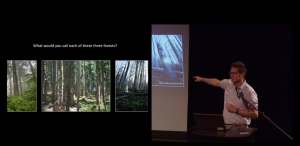
This January, Brian Harvey was invited to give a seminar talk on our research examining the past, present, and future trajectories of forests burned by the 2017 Eagle Creek fire. This talk was given along with presentations from Jessica Hudec and Loretta Duke for the event Wildfire in the Gorge: The Good, The Bad, and Lessons from Eagle Creek, part of the ongoing Sense of Place lecture series hosted by the Mt. Adams institute in Hood River. Check out this talk to learn about our work in Eagle Creek so far, and early insights on drivers of wildfires in the Western Cascades, spatial patterns of vegetation regeneration, and forest trajectories five years post-fire.
Congratulations to Liliana K. Rangel-Parra on thesis defense – Dec 2022
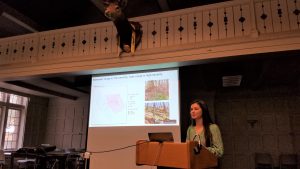
Congratulations to Liliana K. Rangel-Parra for a successful defense of her MS thesis “Laying the groundwork: post-fire complex early-seral forest community trajectories in western Cascadia” in December. Liliana will be staying on in the Harvey Lab as a PhD student starting in Winter 2023. Congrats, Liliana!
Congratulations to Madison Laughlin on thesis defense – Nov 2022
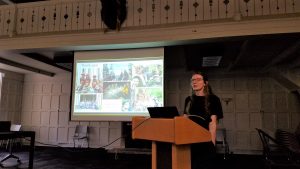
Congratulations to Madison Laughlin for a successful defense of her MS thesis “Patterns and drivers of conifer regeneration following stand-replacing wildfire in western Cascadia” in November. Madison will be staying on in the Harvey Lab as a PhD student starting in Winter 2023. In pursuit of her PhD, Madison will continue to focus on post-fire recovery and resilience in the western Cascades, using both empirical and modeling approaches. Congrats, Madison!
New paper: Fine-scale spatial heterogeneity shapes compensatory responses of a subalpine forest to severe bark beetle outbreak – Nov 2022

In this paper led by Michele Buonanduci, we examined the growth response of surviving conifers at a fine scale after a severe mountain pine beetle (MPB) outbreak in Colorado’s Fraser Experimental Forest. Using a spatially explicit long-term monitoring dataset capturing the period before and after a 2003-2011 MPB outbreak, this study sought to identify how individual and aggregate growth responses vary with tree and neighborhood characteristics. Results indicate that tree growth at the individual and neighborhood level are driven by spatial legacies of the outbreak and pre-outbreak stand: growth releases of surviving trees, as well as overstory recruitment, varied with neighborhood mortality rates and pre-outbreak stand structure. Despite spatial variability in growth responses, aggregate growth of tree basal area remained stable after disturbance, which is consistent with previous findings. This study’s deep dive into the role of spatial heterogeneity as a mechanism of resilience highlights the importance of spatially-explicit modeling of forest recovery post-disturbance. Big Congrats to Michele Buonanduci for this paper! Find the link to this paper in our Publications page!
New paper: Rocky Mountain forests are poised to recover following bark beetle outbreaks but with altered composition – Oct 2022

In this paper co-authored by Brian Harvey and Jenna Morris and led by colleague Kyle Rodman, the team drew from 16 field studies of forested areas across the Southern Rocky Mountains to 1) compare conditions before and after a native bark beetle outbreak, and 2) explore how stand structure and species characteristics vary across subalpine forest stands impacted by bark beetle outbreaks. Post-outbreak trajectories vary by severity, climate, and forest conditions, highlighting the importance of biological legacies and diversity of pre-outbreak conditions. Changes in stand structure due to bark beetle outbreak are projected to grow back to pre-outbreak levels, however changes in species composition are projected to persist long-term. In particular, authors predict compositional shifts towards subalpine fir dominance post-outbreak, which is supported by other findings. Find the link to this paper in our Publications page!
New paper: Trends in forest structure restoration need over three decades with increasing wildfire activity in the interior Pacific Northwest US – Oct 2022

In this paper led by Madison Laughlin, we quantified restoration need across the eastern Washington ecoregion annually from 1986-2017. We used these data to examine the impact of wildfire activity on restoration need trends at three spatial scales: the ecoregion, fire regimes within the ecoregion, and watersheds comprising the frequent/low severity fire regime. The impacts of wildfire on restoration need vary by scale: the change in restoration need across time was unsubstantial at the ecoregion scale – highlighting the magnitude of restoration need across eastern Washington – and greatest at the watershed scale within frequent-fire landscapes, which suggests that wildfires are restoring landscapes at sub-regional and local scales. The scales of analysis in this study provide an important dimension of understanding how the large wildfires of recent years have reduced the amount of forested area in need of restoration in fire-prone forests of eastern Washington. Big congrats to Madison Laughlin on this paper! Find the link to this paper in our Publications page!
New paper: Fire interval and post-fire climate effects on serotinous forest resilience – Sep 2022

In this paper led by Michelle Agne as one of her PhD chapters, we examined the effects of seed supply and post-fire climate conditions on serotinous knobcone pine regeneration in severely burned stands across three fires in Oregon and California. This study sought to distinguish the relative importance of climate conditions and seed availability– factors of resilience–on post-fire serotinous conifer regeneration, an important distinction as the climate warms and fire regimes change. In general, knobcone pine is resilient to the current fire regime and climate of its range. Seed supply was a stronger indicator of success in post-fire recruitment, suggesting that an altered fire regime will be a greater threat to serotinous conifer forest resilience in a warming climate. Big Congrats to Michelle Agne for this paper and a chapter of her PhD published! Find the link to this paper in our Publications page!
New paper: Reimagine fire science for the Anthropocene – Aug 2022
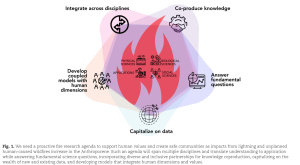
In this paper led by Jacquelyn K. Shuman, 88 authors (including Brian Harvey) identify and expand on five challenges to reframing fire science. These challenges are calls to more integrative and inclusive science across disciplines, expertise, perspectives, and knowledge generation. In several aspects of fire science, authors identify knowledge gaps, suggestions for improvement in data sharing and collaboration, and barriers with funding sources. This paper is a synthesis of topical challenges to the progress of fire science, from an interdisciplinary cohort of fire science leaders. Find the link to this paper in our Publications page!
New grants/fellowships: Congrats to Jenna Morris! – May 2022

This spring, PhD student Jenna Morris was selected for the 2022 cohort of NW Climate Adaptation Science Center Research Fellowship Program! Her selection as a NW CASC Fellow will support research on trajectories of post-fire recovery in forests across western Washington and Oregon, exploring questions using field data and simulation models to inform management options under changing climate conditions. Jenna will officially begin the fellowship in Fall 2022. Congratulations Jenna!
Congratulations to Dr. Michelle C. Agne, the 1st Harvey Lab PhD! – June 2022
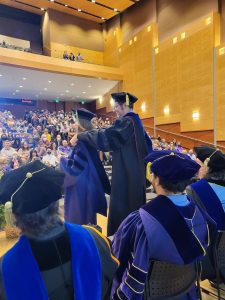
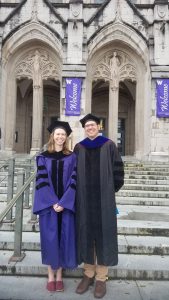
Congrats to Dr. Michelle C. Agne, who is now the inaugural Harvey Lab PhD alum! After the first in-person graduation ceremony for SEFS and UW since 2019, we were able to monument Dr. Agne’s graduation with the official PhD hooding in the company of the SEFS community, other graduating BS/MS/MFR/PhD students, and their families. Congrats Dr. Agne!
Congratulations to Michelle Agne on dissertation defense – May 2022


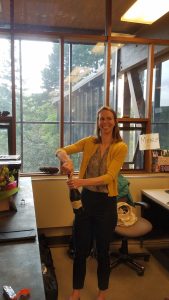
BIG congrats to Michelle Agne for a successful defense of her PhD dissertation “Serotinous forest resilience in a warmer and more fire-prone world” in late May! Michelle will be wrapping up her PhD in the next few weeks before starting a ORISE postdoctoral fellowship with the US Forest Service – Pacific Northwest Research Station in July. Congrats Michelle!
Welcome to the lab – Angie Gonzalez! – May 2022

In September 2022 the Harvey Lab will welcome new incoming graduate student Angie Gonzalez, who will begin her PhD research examining the impacts of fire and climate on regeneration in the eastern cascades. Angie arrives here with her M.S. in Forest Science from Colorado State University where her research focused on the impacts of drought on resource allocation patterns in ponderosa pine. Welcome Angie!
Congrats to Brian Harvey, selected as Early Career Fellow for the Ecological Society of America! – Apr 2022

Lab PI Brian Harvey was nominated for and selected into the class of 2022 Early Career Fellows of the Ecological Society of America, in recognition of making significant impacts in the field of fire and disturbance ecology within eight years of completing his doctoral training. According to the nomination and announcement, Brian was selected for “deepening understanding of the effects of natural disturbances, especially fire and insect outbreaks, on resilience and management of forests in the U.S. West; for excellence in science communication and outreach; and for outstanding teaching and mentoring at all levels from undergraduate to advanced graduate.” Here’s the announcement from ESA and a UW News story about Brian and fellow ESA Fellow Julian Olden (UW SAFS).
New paper: Understanding the effects of stand structure, fire interval, and climate on post-fire resilience in California serotinous bishop and knobcone pine stands – Feb 2022
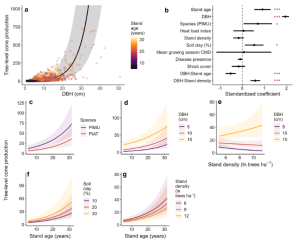
In this paper, led by Michelle Agne as one of her PhD chapters, we examined the effects of biotic and abiotic factors on two critical demographic processes一reproductive capacity and mortality一in serotinous pine stands across the early stages of post-fire development. Reproductive capacity increases sharply around ten years after fire disturbance, and immaturity risk一the failure to accumulate a sufficient canopy seed bank一is low after 20 years. Big Congrats to Michelle Agne for this paper and a chapter of her PhD published! Find the link to this paper in our Publications page!
New paper: Exploring the relationship between the Composite Burn Index (CBI) and quantitative field measures of burn severity – Jan 2022
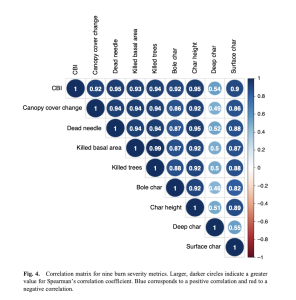
In this paper, led by Saba Saberi as one of her MS chapters, we examined the consistency of the CBI in capturing various levels of burn severity through two focal questions: how consistently CBI relates to other field metrics, and 2) how the relationships between CBI and other field metrics vary with forest structure. CBI is an important technique in capturing burn severity across forest structure gradients, and generally corresponds well with other field metrics. Where CBI is limited in its capacity to capture certain burn severity measures such as deeply charred snags, we suggest additional field measures that could be added to CBI. Big Congrats to Saba Saberi for her first lead-author paper!
Call for applications: Summer 2022 Paid Field Assistant Positions – Forest & Fire Ecology Research – Feb 2022
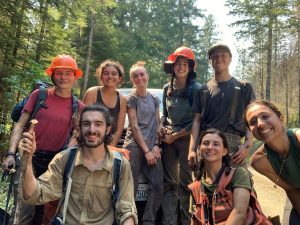
We are hiring 4-6 field assistants to work on research projects in forests of the western Cascades during the summer 2022 field season. Please see the “Join” page for more information, and see the position description for information on how to apply. We will begin reviewing applications on March 11, but positions are open until filled.
Welcome to the lab – Sofia Kruszka! – Jan 2022
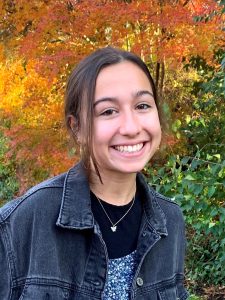
In January 2022 the Harvey Lab welcomed assistant research scientist Sofia Kruszka, who will work on a number of projects related to forest ecosystem dynamics and resilience across western Cascadia and the Pacific Northwest. Sofia was a member of the Harvey Lab’s 2021 field crew, and arrived here with a B.S. (with distinction) in Ecology, Evolution, and Biodiversity from the University of Michigan. Welcome, Sofia, we’re excited to have you back in the lab in your new role!
Congrats to grad student Jenna Morris! – Dec 2021
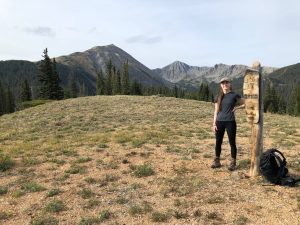
Congrats to PhD student Jenna Morris on presenting her poster on fuel profiles and woody carbon following recent fires in western Cascadia at the AFE Fire Congress… and winning 1st place in the student poster contest! Awesome work Jenna!
Invited seminar talk on our research projects on forest fires in Western Cascadia – Nov 2021
This November, Brian Harvey was invited to give an hour-long seminar talk on our research examining the causes, characteristics, and effects of recent fires in Western Cascadia. This talk was part of the ongoing seminar series from the Cascadia Wildfire and Urban Smoke Working Group. Check out this talk to learn about our work that is supported from multiple grants and that is co-produced with state, Tribal, local, and Federal partners, where we are looking at what drives fires in western Cascadia, what are the characteristics of these fires and their spatial patterns, and what are their effects for post-fire vegetation trajectories and future disturbance probability.
Seven(!) #HarveyLab talks or posters at the 2021 Association for Fire Ecology – Fire Congress Meeting – Nov 2021
The Harvey Lab is representing big time at the 2021 AFE Fire Congress Meeting. Come check out our research on wildfire and forest response on the Westside of the Cascades in the PNW (posters by Liliana Rangel-Parra, Jenna Morris, and Madison Laughlin, talks by Michele Buonanduci and Brian Harvey), the Eastside of the Cascades (talk by Don Radcliffe), and serotinous pines in California and Oregon (talk by Michelle Agne). We’re excited to share our work and learn about other research being presented at the meeting!
Congrats to grad student Don Radcliffe! – Nov 2021
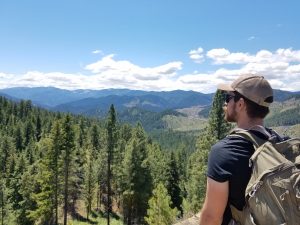
Congrats to PhD Candidate(!) Don Radcliffe on passing his PhD General Exam in November, with his PhD proposal ‘Ecological forest management of fuel and restoration treatments in dry forests of western North America’ now officially on the books. This winter quarter he’ll be working on the first draft of the first chapter of his dissertation. Way to go, Don!
New book chapter – Hood et al. 2021 Fire Ecology of Rocky Mountain Forests – Oct 2021
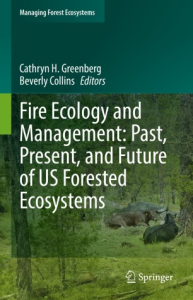
In this chapter of the book Fire Ecology and Management: Past, Present, and Future of US Forested Ecosystems (Greenberg C.H., and Collins, B., eds), Sharon Hood, Brian Harvey and co-authors provide a comprehensive review of the fire ecology and fire-related management issues in the major forest types of the Rocky Mountains. This is one chapter in a recent book that includes additional chapters of other forested ecoregions in the United States. Check out the chapter here and the entire book here.
New paper: historical thinning treatments and resilience to bark beetle outbreaks in subalpine forests – Oct 2021
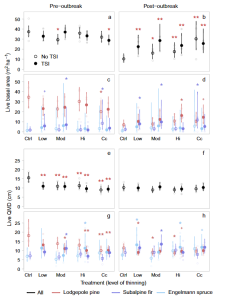
The first chapter of Jenna Morris’s MS thesis was published in Ecological Applications! In this study, we examined the effects of historical thinning intensity in Fraser Experimental Forest on resistance to mountain pine beetle outbreak and post-outbreak successional trajectories in susceptible lodgepole pine stands. Historical thinning had little effect on resistance to mountain pine beetle outbreak, but impacted the post-outbreak successional trajectories. Congrats Jenna! Here’s a link to the paper in Ecological Applications!
New book chapter – Harvey et al. 2021 Landscape Ecology – the Disturbance regime concept – Sep 2021

In this chapter of the book The Routledge Handbook of Landscape Ecology (Francis, R.A., Millington, J.D.A., Perry, G.L.W., and Minor, E.S., eds), Brian Harvey, Sarah Hart, and Alina Cansler provide a synthesis of the importance of disturbance ecology in the development of landscape ecology, the conceptual underpinnings of the disturbance regime concept, and cover several past, current, and emerging themes in the landscape ecology of disturbances, such as resilience, scale, thresholds, and interacting stressors under global change. Check out the book here.
New grants/fellowships – Congrats to Michele Buonanduci! – Sep 2021
This fall, PhD candidate Michele Buonanduci joined the 2021 cohort of NW Climate Adaptation Science Center Research Fellows! Her selection as a NW CASC Fellow will support research of spatial patterns of burn severity in western Washington and Oregon, working collaboratively with partners at the Washington DNR to provide insights for land managers in this region.
Our research was featured in hour-long special: Scorched Earth: Why WA wildfires are getting bigger – Sep 2021
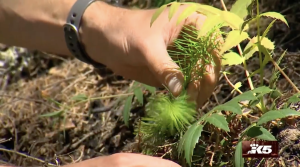
Our research examining post-fire forest dynamics and regeneration in western Cascadia was featured in a 45-minute segment published by KING 5 News on Thursday, September 9! Watch interviews with Jenna Morris, Dan Donato, Josh Halofsky, and Brian Harvey.
Our research on westside fires was featured by King 5 News – Jun 2021
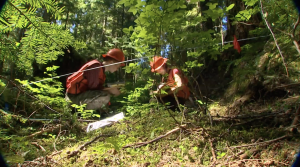
Our research examining post-fire forest dynamics and regeneration in western Cascadia was featured in KING 5 News! Watch interviews with Jenna Morris, Dan Donato, Josh Halofsky, and Brian Harvey in a 2-minute prime time segment published on Friday, June 25.
New grant (USDA NIFA) to measure post-fire carbon and fuel profiles in the Western Cascades – Apr 2021
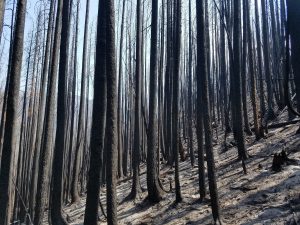
This winter, we were fortunate to be selected for a new grant to build out additional components of our research on the causes and effects of fire in Western Cascadia. We were selected for a grant from the USDA NIFA Program to build on additional measurements and analyses of carbon and fuels to our existing network of post-fire plots in recently burned forests in western Cascadia (WA and northern OR). This extends collaborations with the WA Department of Natural Resources and work will begin in summer/fall 2021.
PAID Field Assistant positions for Summer 2021 in the Harvey Lab; Apply Now! – Feb 2021

We are hiring 7-9 field assistants to work on research projects in recently burned and old-growth forests of the western Cascades during the summer 2021 field season.. Please see the “Join” page for more information, and see the position description for more information on how to apply. We will begin reviewing applications on Feb 26. Apply now!
New paper: Factors associated with subalpine fir mortality across spatial scales in the US Rocky Mountains – Jan 2021
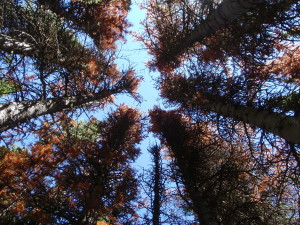
In this paper, we examined factors were associated with forest mortality (subalpine fir decline) across four spatial scales in the US Rocky Mountains, spanning subcontinental extents to individual trees and their neighbors. While broad scale temporal patterns in subalpine fir mortality were associated with periods of drought, local-scale biotic processes mediated mortality at fine scales, and mortality was greatest spatially in locally mesic sites. Large subalpine fir trees and those near dead neighboring trees were most likely to die in recent mortality events. Here’s a link to the paper in Ecosphere!
Congratulations to Jenna Morris on thesis defense – Dec 2020
Congratulations to Jenna Morris for a successful defense of her MS thesis “Cutting a course: examining the effects of historical thinning treatments on directing forest response to bark beetle outbreaks” in December. Jenna will be staying on in the Harvey Lab as a PhD student starting in Winter 2021. The focus for her PhD will be on post-fire carbon dynamics and reburn potential in western Cascadia forests under a warming climate. Congrats, Jenna!
New paper: How growth rate and neighborhood context affect tree survival in a beetle outbreak – Congrats to Michele Buonanduci! – Aug 2020
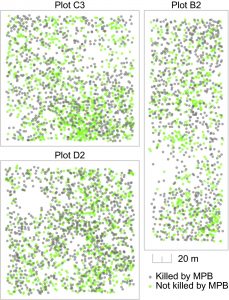
In this paper, led by PhD student Michele Buonanduci, the effects of tree growth rate and neighborhood context leading up to a bark beetle outbreak on mortality probability were tested. Large trees (> 30 cm dia) nearly all died; small trees (<10 cm dia) nearly all survived, but for trees of intermediate size, their neighbors and how fast they grew prior to the outbreak mattered for survival probability. Congrats Michele! Here’s a link to the paper in Ecosphere!
Welcome to the lab – Liliana Rangel-Parra – Sept 2020

In September 2020 the Harvey Lab welcomes new incoming graduate student Liliana Rangel-Parra, who will begin her MS research on our projects examining post-fire vegetation response and early-seral plant communities following the recent fires on the westside of the Cascades. Liliana is a Gates Millennium Scholar and arrives here with a B.S. (with honors) in Ecological, Environmental, and Evolutionary Biology from Appalachian State University where her undergraduate research focused on plant ecology and ecophysiology. Welcome Liliana!
Two new grants to study fires and forest response of the Western Cascades – Apr/May 2020
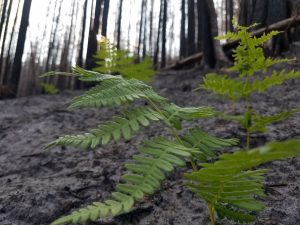
This spring, along with our collaborators, we were fortunate to receive funding for two projects to continue our research on the causes and consequences of fire in western Cascadia. We were awarded a USGS NW Climate Adaptation Science Center grant to study the climate and weather drivers of westside fires, as well as to understand how post-fire climate affects forest regeneration in N OR and WA. In addition, we were selected for a USFS PNW Initiative to expand our plot network begun on the Norse Peak Fire to better understand how pre-fire forest conditions, burn severity, and landscape context shape post-fire early seral conditions and post-fire succession across additional fires in N OR and WA. This work is in collaboration with Daniel C. Donato (WA DNR); Joshua Halofsky (WA DNR); Crystal Raymond (UW); Philip North (Tulalip Tribes); Nick Bond (UW); Karin Bumbaco (UW); Jerry F. Franklin (UW-SEFS); Dave W. Peterson (USFS).
Here’s a video field tour from 2019 of our research sites in the Mount Baker Snoqualmie National Forest: https://www.washington.edu/news/2019/08/23/wildfires-are-possible-on-the-west-side-of-the-cascades/
PAID Field Assistant positions for Summer 2020 in the Harvey Lab; Apply Now! – Jan 2020

We are hiring 5-7 field assistants to work on several research projects in forests across the western US during summer 2020. Please see the “Join” page for more information, and see the position description flier for more information on how to apply. We will begin reviewing applications on Feb 21. Apply now!
Congratulations to Saba Saberi on thesis defense – Dec 2019

Congrats to Saba Saberi for a successful defense of her MS thesis “Quantifying burn severity in forests of the interior Pacific Northwest: From field measurements to satellite spectral indices” on Dec 10. Starting in winter 2020, Saba will be working as an analyst in UW-SEFS working for the Precision Forestry Cooperative. Congrats Saba – the first grad student from the original Harvey Lab cohort to graduate!
Congratulations to Michele Buonanduci on thesis defense – Nov 2019
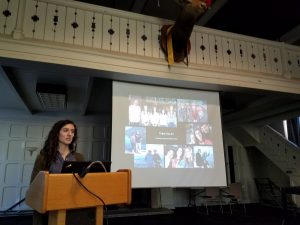
Congrats to Michele Buonanduci for a successful defense of her MS thesis “Spatial modeling of lodgepole pine mortality and implications for drivers of bark beetle outbreaks” on Nov 21. Michele will be saying on in the Harvey Lab as a PhD student starting in winter 2020. Congrats Michele – the first graduate degree defense in the Harvey Lab!
Welcome to the lab – Madison Laughlin and Andrea Duane – Nov 2019

In November 2019 the Harvey Lab welcomes two new members. Madison Laughlin (photo above, left) joins the Harvey Lab as a research scientist working on a project with Jon Bakker and Ernesto Alvarado (SEFS) and collaborators at the WA DNR on forest structure, fire risk, and restoration opportunities in eastern Washington. Also joining us just for the month of November is visiting scientist Andrea Duane (photo above, right), who is a postdoc visiting us from Spain, where she works with Lluis Brotons on forest disturbance landscape modeling in fire-prone Mediterranean ecosystems. Welcome Madison and Andrea!
Video tour about Our Westside Fires research – Aug 2019
Here’s a glimpse into our research projects exploring the causes and consequences of wildfires on the west side of the Cascades, a collaboration with Dan Donato and Josh Halofsky at the Washington Department of Natural Resources.
New grants/fellowships – congrats to Michelle Agne! – Sept 2019

Last spring, PhD student Michelle Agne was hard at work preparing for her PhD general exam, as well as preparing two research proposals. This summer and fall, PhD *candidate* (as she passed her PhD general exam in June!) was selected for funding for BOTH of the proposals she submitted. In brief, Michelle will be funded by the Joint Fire Sciences Program for a Graduate Innovation Award to expand her research on the fire ecology of knobcone pine in California and her selection as a NW Climate Adaptation Science Center Fellow will allow her to expand this work to Oregon and Washington, and co-produce insights with land managers. Congrats Michelle!
Welcome to the lab – Don Radcliffe – June 2019

Don Radcliffe joined the Harvey Lab in 2019 as a new PhD student. Don joins us after completing his MS at The Ohio State University. Don will start his PhD research on our lab projects looking at fire ecology and management in forests on the east side of the Cascade crest. His initial work in summer 2019 is focusing on re-measurements of the Fire and Fire Surrogates project in Mission Creek WA (which he is admiring in this photo!). Welcome Don!
PAID Field Assistant positions for Summer 2019 in the Harvey Lab; Apply Now! – Feb 2019
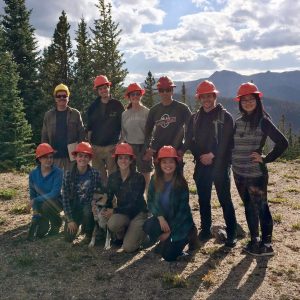
We are hiring 3-5 field assistants to work on our projects on fire ecology and forest ecology in the Cascade Mountains in summer 2019. Please see the “Join” page for more information, and see the position description flier for more information on how to apply. We will begin reviewing applications on March 4. Apply now!
New grant (National Science Foundation) to examine forest disturbance and resilience – March 2019
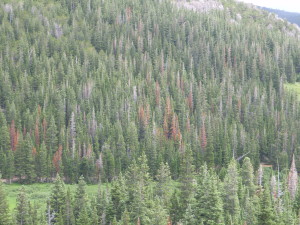
Our grant proposal “Spatiotemporal Interactions Among Biotic Disturbance Agents, Biological Legacies, and Compensatory Responses: Consequences for Temperate Forest Resilience” was selected to be funded by the National Science Foundation Divisions of Environmental Biology and Geography and Spatial Sciences. We can’t wait to get started on this project, which will involve co-PIs Dr. Patrick Tobin (UW-SEFS), Dr. Sarah Hart (University of Wisconsin), and Dr. Dan Donato (Washington Department of Natural Resources). Read more about it here and stay tuned as we post more updates!
New paper: incorporating biophysical gradients and uncertainty into burn severity maps – Feb 2019
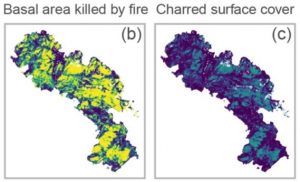
In this paper, led by Dr. Harvey and in collaboration with Robert Andrus (University of Colorado) and Sean Anderson (DFO Canada), we assess how satellite indices that are used to map forest fire severity relate to unique components of ‘on-the-ground’ measures of burn severity, and how models can be improved by incorporating information on geography, topography, and forest conditions prior to the fire. We also explore the consequences of uncertainty in burn severity maps, and what that means for spatial patterns of fires. Here’s a link to the paper in Ecosphere!
New grant (UW Royalty Research Funds) to initiate research project on fires of the Western Cascades – Jan 2019

We were awarded a University of Washington Royalty Research Funds grant to build our research program looking at fires and post-fire forest response on the west side of the Cascade Mountains. This particular project will be using the Norse Peak Fire (burned in 2017 immediately NE of Mt. Rainier National Park) as a focal research site. Fieldwork will begin summer 2019!
PhD Student Michelle Agne passes her Qualifying Exam – Jan 2019

We celebrated a milestone event when Michelle Agne became the first Harvey Lab graduate student to pass their PhD Qualifying Exam in January 2019. Michelle’s PhD research is working on our project looking at how climate warming and increased fire frequency are affecting serotinous conifer forests, where she is using the California Closed Cone Pines as a model system to test hypotheses. Congratulations Michelle!
Seeking new PhD student to study fire ecology and forest resilience in the Cascade Mountains – Oct 2018

Dr. Harvey is seeking a prospective PhD student interested in studying fire ecology and forest resilience on the east and west side of the Cascade Mountains. The ideal candidate will start in late spring or early summer 2019 to begin fieldwork in the eastern Cascades prior to the 2019-2020 academic year. Click here for more information!
Our research was featured on the front page of the Seattle Times – Sep 2018

Our research examining burn severity in forests across the interior Pacific Northwest and a budding project to examine post-fire forest dynamics on the west side of the Cascade Mountains were featured on the front page of the Seattle Times on Tuesday Sept. 4. Check out the article here, featuring interviews from the field with Jerry Franklin, Josh Halofsky, and Brian Harvey!
New Grant (USDA NIFA): Forest resilience to fire in WA – Aug 2018
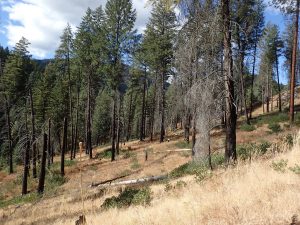
We were awarded a new grant from the USDA NIFA Program to test how past fuel treatments affect resistance and resilience to severe fire in dry forests on the eastern slope of the Cascades. This project will be in collaboration with researchers at the Washington State Department of Resources. Work will begin in early-mid 2019!
Video about NSF-RAPID project in Yellowstone – Aug 2018
What might subalpine forests look like in a warmer future with more frequent and severe fire? Here’s a glimpse into our project exploring this in Yellowstone, a collaboration between the Turner Lab at the University of Wisconsin and the Harvey Lab at the University of Washington.
Congrats to undergrads Amber Noble and Luke Semler! – June 2018

A big congrats to Amber Noble and Luke Semler, who both completed their UW-SEFS Senior Capstone Projects in the Harvey Lab. Amber researched the historical and contemporary environmental correlates of western red cedar distribution on the Olympic Peninsula, and Luke researched the relationship between site productivity and subalpine fir mortality in Colorado. Congrats to both on a job well done, on graduating in June, and on becoming new parents!
Congrats to grad students Michelle Agne and Saba Saberi! – May 2018
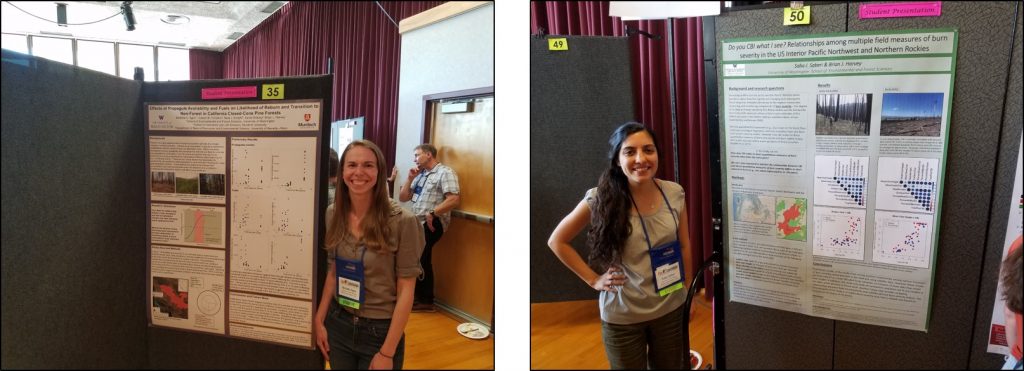
Michele and Saba won 1st and 2nd place, respectively, in the student poster contest at the 2018 Association for Fire Ecology / International Association for Wildland Fire Fire Continuum Conference in Missoula, MT. Congrats to Michelle and Saba! Go #HarveyLab!
New Grant (USGS NWCASC): Changing Climate and effects on forests in PNW – Aug 2017
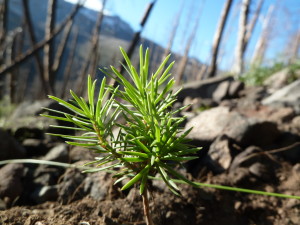
We have been awarded a new grant from the USGS Northwest Climate Adaptation Science Center to synthesize the effects of a changing climate on forests and forest disturbances (e.g., fire, insect outbreaks) in the Pacific Northwest region. This project will involve compiling a review paper and several research briefs, and is in collaboration with researchers at the US Forest Service and UW-SEFS.
New Grant (USFS GTAC): Burn severity in the field and from space in the Northwest – June 2017

We were awarded a grant from the USFS Geospatial Technologies Applications Center to improve models that related field measures of burn severity to satellite indices that are widely used to map burn severity in forests across the Pacific Northwest. This project will involve establishing >300 field plots in forests in WA, OR, ID,, MT, and WY that burned in 2016 or 2017 and then relating those field measures to satellite indices. The project is in collaboration with researchers at the US Forest Service.
New Grant (USDA NIFA): Forest disturbance and old growth in subalpine Rocky Mountains – May 2017

We were awarded a grant from the USDA NIFA Program to test how past management history affects susceptibility to mountain pine beetle outbreaks, and what the intersection of management x beetle outbreak means for fire risk and forest stand development. This project will involve re-surveying plots at Fraser Experimental Forest in Colorado that were established in 1937, and is in collaboration with researchers at Oregon State University and the US Forest Service.
New Grant (NSF RAPID): Short-interval reburns – Feb 2017

We have been awarded a grant from the National Science Foundation to examine what happens to subalpine forests in the Northern Rocky Mountains when they experience two severe fires in an anomalously short interval. This occurred when the 2016 Maple Fire burned >18,000 hectares of forest that had burned in the 1988 Yellowstone Fires. This project involves collaboration with researchers at the University of Wisconsin – Madison.
the Harvey Lab at UW begins! – Mar 2017
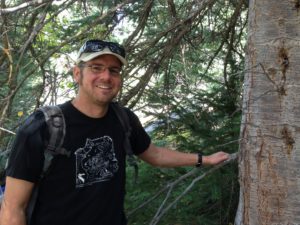
Dr. Brian Harvey has accepted a tenure track position as Assistant Professor in the School of Environmental and Forest Sciences at the University of Washington, and is looking to grow his lab. See the story written in the SEFS blog Offshoots.

